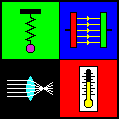|
In this Java simulation the hydrostatic pressure of a liquid is measured with an U-tube manometer. On the upper side of the red coloured chamber there is a membrane which is deformed more or less, depending on the pressure. Consequently the pressure of the air in the connected tube (pink) increases so that the liquid sinks in the left part of the U-shaped tube and rises in its right part. The displacement of the liquid's level measures the hydrostatic pressure.
Remark 1: It is supposed that the liquids in the U-shaped tube
and in the container are the same.
Remark 2: Note that only the hydrostatic pressure of the liquid is registered, not the pressure of the air!
The problem of this simulated experiment is the relation between hydrostatic pressure and depth. You can raise or lower the manometer with pressed mouse button. On the right side it is possible to select one of several liquids. In addition, you can write the values of density and depth directly into the text fields.
On the lower right the applet will indicate the measured hydrostatic pressure (in hPa).
(1 hPa = 1 Hektopascal = 100 Pa = 100 N/m2)
You can see that the hydrostatic pressure of water increases by about 1 hPa for each cm of depth.
The following formula is more general:
| p = g r h |
p ... hydrostatic pressure of the liquid g ... gravitational acceleration r ... density of the liquid h ... depth
![]()
 |
| Physics Applets (Overview) |
URL: http://home.a-city.de/walter.fendt/phe/hydrostpr.htm
© Walter Fendt, February 3, 1999
Last modification: December 20, 1999